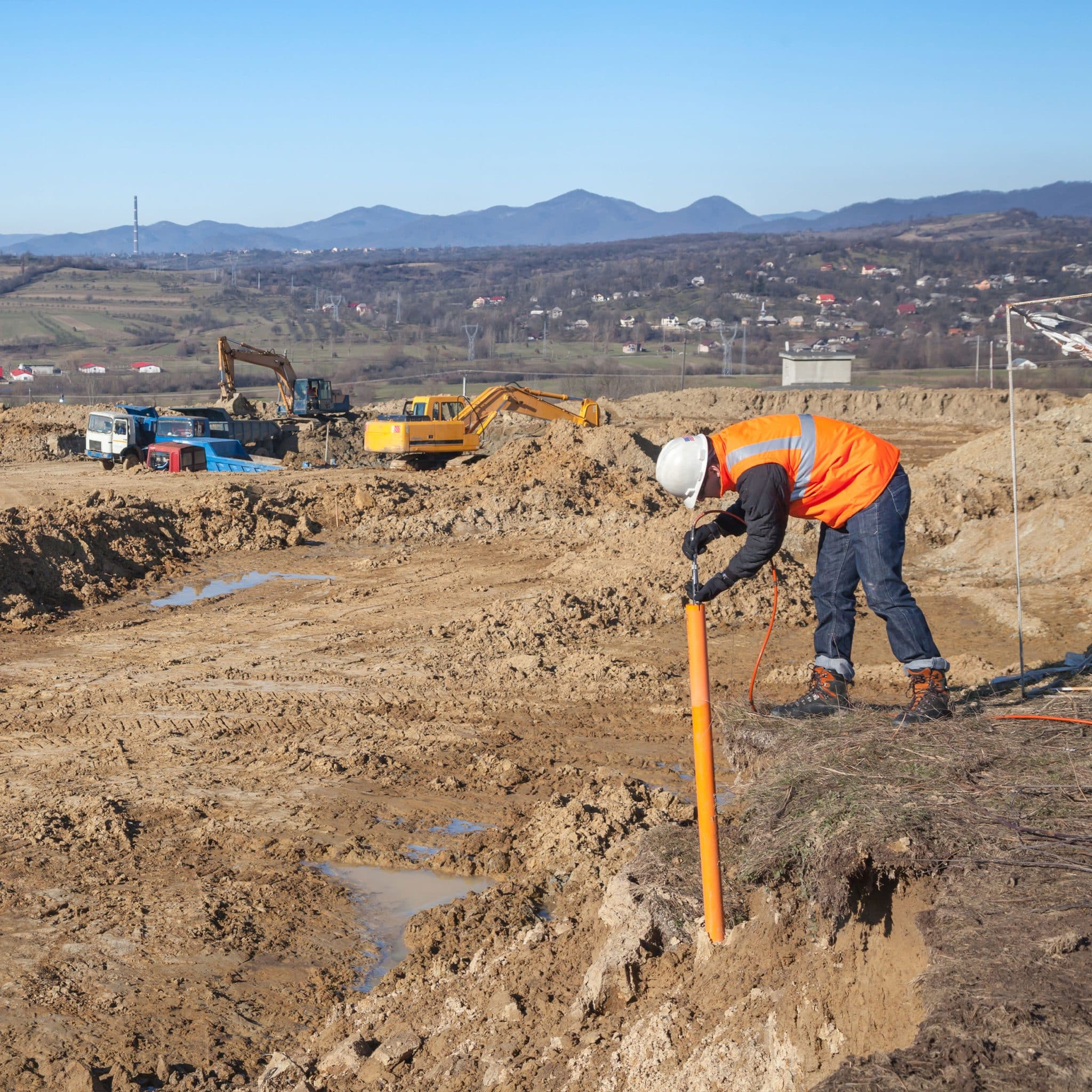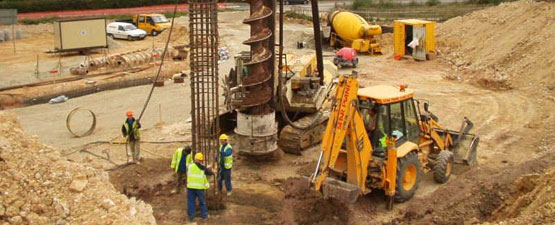Browsing the Complexities of Geotechnical Eng Projects
Browsing the Complexities of Geotechnical Eng Projects
Blog Article
A Thorough Overview of the Key Obligations of Geotechnical Engineers in Site Characterization and Ground Renovation Methods for Design Solutions
Geotechnical designers are indispensable to the successful execution of design projects, entrusted with the critical responsibilities of site characterization and the application of ground improvement techniques. Their work includes an extensive analysis of subsurface conditions, using various screening methods to determine soil and rock homes.
Role of Geotechnical Designers
Geotechnical engineers play a critical role in the style and construction of framework by examining the actions of dirt and rock below the surface area - geotechnical industry. Their duties include evaluating subsurface conditions to educate design choices that ensure architectural security and safety. By conducting thorough evaluations of dirt residential properties, including shear stamina, permeability, and compressibility, geotechnical engineers give critical data that affects the choice of suitable construction products and methods
Along with examining soil mechanics, geotechnical designers are tasked with determining possible threats such as landslides, sinkholes, and ground negotiations. Their proficiency assists mitigate threats related to these geotechnical phenomena, consequently safeguarding both the setting and public safety and security. They also work together closely with other engineering self-controls, making sure that geotechnical factors to consider are integrated right into total job layout.
Additionally, geotechnical designers take part in the assessment of existing structures, supplying referrals for retrofitting and repairs when needed. Their thorough understanding of soil-structure interaction is essential for the development of sustainable facilities remedies. In general, the role of geotechnical engineers is indispensable to the effective realization of building projects, ensuring they are secure, resilient, and compliant with governing criteria.

Website Characterization Procedures
Effective website characterization procedures are necessary for recognizing the subsurface problems that influence project layout and implementation. Geotechnical engineers utilize a methodical approach to gather, review, and interpret information relating to groundwater, rock, and dirt qualities. This process begins with an extensive testimonial of existing literature and historic site information, giving insights into previous site problems and potential challenges.

Data evaluation adheres to fieldwork, where engineers make use of geostatistical methods to interpret searchings for and produce geological models. With attentive site characterization, geotechnical designers lay the groundwork for successful job implementation, maximizing and reducing unpredicted issues source allotment.
Dirt and Rock Testing Methods
While comprehending subsurface conditions is vital, the selection of suitable soil and rock testing methods is similarly vital for exact evaluation and design. Geotechnical designers utilize a selection of testing techniques to assess the physical and mechanical buildings of dirt and rock products.
Research laboratory examinations, such as Atterberg limits, grain size analysis, and unconfined compressive strength examinations, give necessary information on dirt habits under various wetness conditions and loading scenarios. These examinations help establish dirt category and anticipate settlement or shear strength characteristics crucial for foundation layout.
In-situ testing methods, consisting of Requirement Infiltration Tests (SPT), Cone Infiltration Examinations (CPT), and pressure meter examinations, allow designers to collect data straight from the ground. These techniques use beneficial insights into the dirt's thickness, consistency, and stratification without the demand for extensive sampling.
Rock screening typically entails core sampling and laboratory evaluation to examine buildings like uniaxial compressive strength and rock quality classification (RQD) Together, these dirt and rock testing methods make it possible for geotechnical engineers to make enlightened decisions regarding site-specific obstacles, making sure the safety and security of design services.
Ground Renovation Methods
Ground renovation strategies are essential for improving the engineering properties of dirt, therefore boosting its load-bearing capability and reducing settlement. These techniques are essential in resolving challenges provided by troublesome my latest blog post or weak dirts, which can considerably impact the stability and toughness of frameworks.
Various ground improvement strategies are employed, consisting of compaction, grouting, and soil stablizing. Compaction involves enhancing the thickness of dirt through mechanical methods, which boosts its shear strength and decreases compressibility. Grouting, on the other hand, entails infusing a liquid product into the ground to load voids and boost soil communication. This method is especially efficient for dealing with loosened sands or broken rock.
Soil stabilization encompasses an array of approaches, from chemical ingredients to mechanical therapies, focused on improving the dirt's resistance to erosion and contortion. Techniques such as lime stabilization or concrete blending change the buildings of the dirt at a fragment level, enhancing its overall efficiency.
Relevance of Geotechnical Analyses
Geotechnical assessments play a vital duty in the planning and layout of design jobs, as they provide essential details regarding the subsurface conditions. Understanding dirt residential properties, rock formations, groundwater levels, and possible geohazards is important for ensuring the security and safety of frameworks. These evaluations enable designers to make informed choices relating to website choice, design parameters, and building and construction methods.
The significance of geotechnical analyses extends past initial task phases; they contribute in threat monitoring and cost efficiency. By recognizing prospective problems early, such as dirt settlement, incline instability, or extreme groundwater, engineers can create suitable mitigation methods, minimizing the chance of architectural failings and pricey delays. These assessments sustain compliance with regulatory needs and enhance the sustainability of engineering techniques.

Verdict
Finally, geotechnical designers are vital to guaranteeing the security and stability of design projects with comprehensive website characterization and ground enhancement methods. geotechnical industry. Their systematic strategy to examining subsurface problems, combined with their suggestions for effective ground alteration, considerably boosts soil residential or commercial properties and load-bearing capability. The competence of geotechnical designers not only helps with enlightened project preparation but likewise guarantees compliance with laws and fosters efficient interaction amongst stakeholders, inevitably contributing to effective design end results
Geotechnical engineers play a crucial duty in the design and building of framework by evaluating the behavior discover this of dirt and rock below the surface. By performing thorough evaluations of soil homes, consisting of shear leaks in the structure, strength, and compressibility, geotechnical engineers give essential information that affects the choice of proper building products and strategies.
In enhancement to examining dirt auto mechanics, geotechnical designers are charged with determining potential hazards such as landslides, sinkholes, and ground negotiations. Geotechnical engineers use an organized technique to collect, evaluate, and interpret data pertaining to soil, groundwater, and rock qualities. By identifying potential concerns early, such as dirt negotiation, incline instability, or excessive groundwater, designers can devise suitable reduction strategies, minimizing the likelihood of architectural failings and costly hold-ups.
Report this page